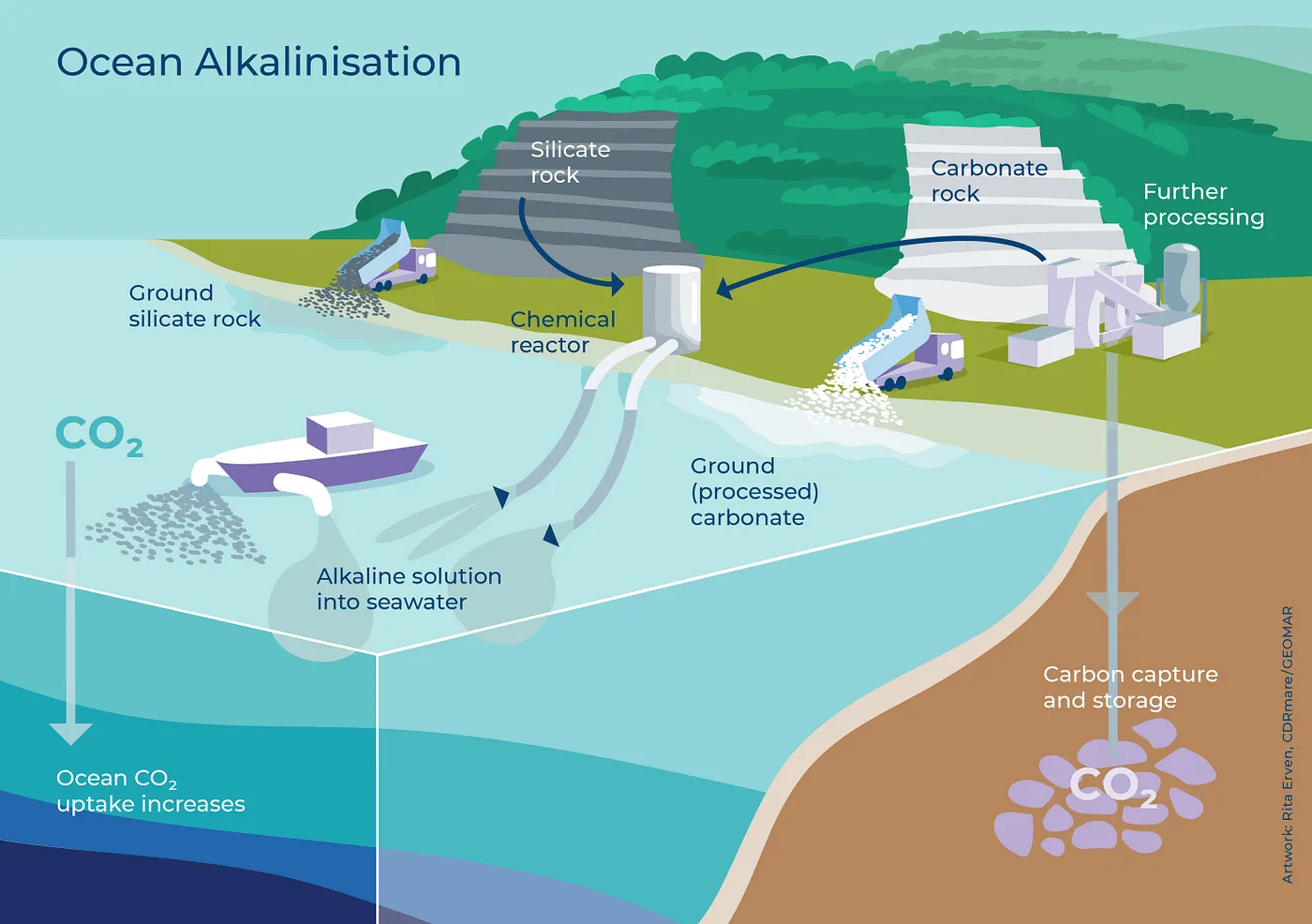Ocean alkalinity enhancement (OAE) is a geo-engineering technique and carbon dioxide removal (CDR) technology that involves adding alkaline substances, such as crushed limestone (carbonate rock) or calcium hydroxide and olivine (silicate rock), to the ocean in order to increase its alkalinity. This technology has the theoretical potential to sequester 1–15+ Gt CO2/ year with a residence time of ~10,000 years¹.
There are several ways to add alkalinity to the ocean. These include spreading finely ground alkaline substances over the open ocean, depositing alkaline sand or gravel on beaches or coastal seabeds, and reacting seawater with alkaline minerals inside specialised fuel cells before releasing it back into the ocean. These can be seen in figure 1.
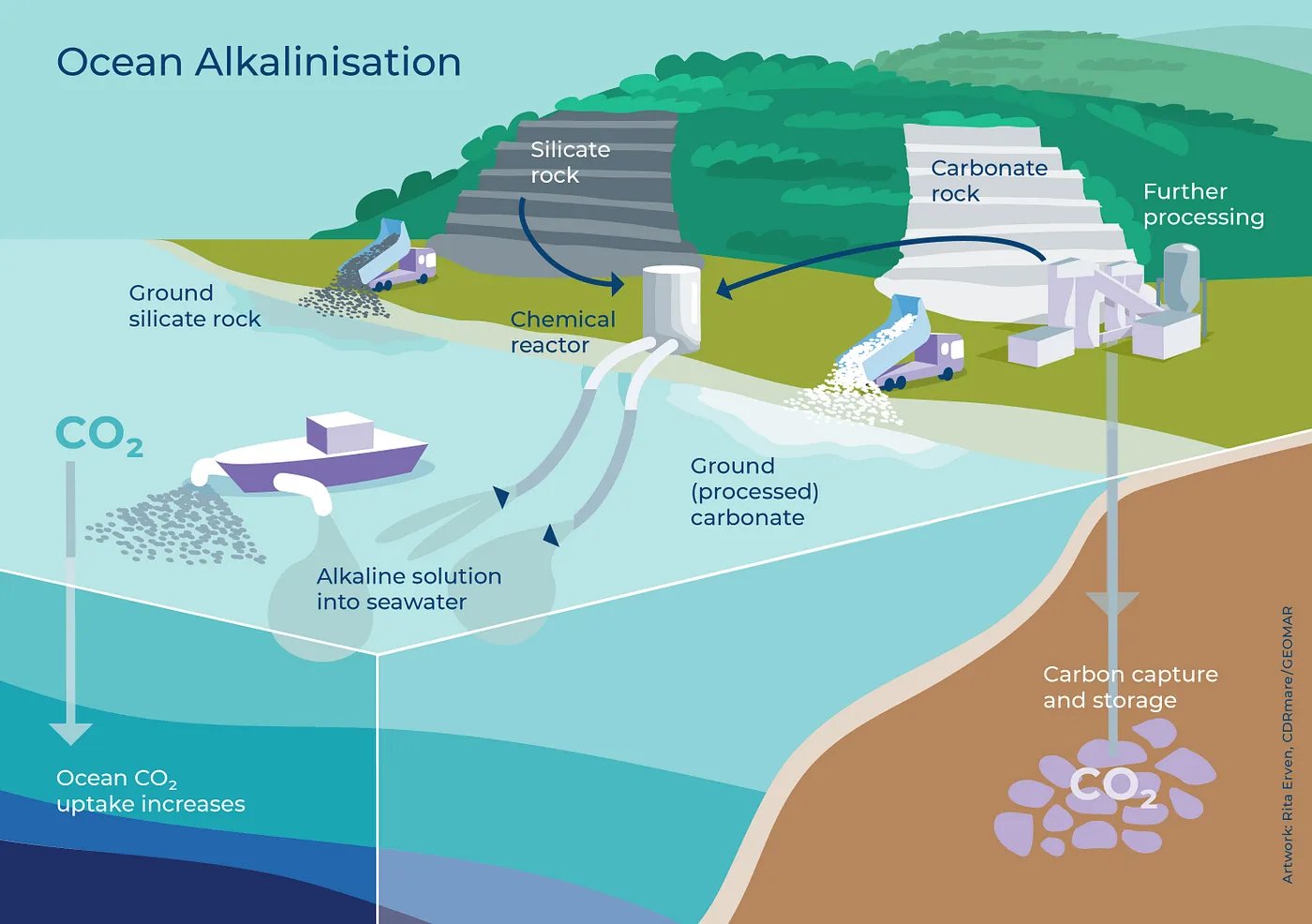
The Ocean, Climate Change and Increase of Atmospheric CO2 Concentration
Oceans cover ⅔’s of the world’s surface, absorbing 90% of the Earth’s excess heat and removing approximately ¼ of CO2 from the atmosphere.²
In the 200 years since the industrial revolution began, the concentration of CO2 in the atmosphere has increased due to anthropogenic activity and subsequently caused the ocean’s sea level, temperature and acidity to increase. These dramatic changes in the ocean’s properties are impacting the biosphere: harming marine life, supply chains, and human livelihoods.
The process of OAE aims to reduce the amount of carbon dioxide in the atmosphere by increasing the ocean’s capacity to absorb it. When CO2 dissolves in seawater, where the rate of CO2 entering the ocean has increased due to anthropogenic activity, it reacts with water to form carbonic acid, which lowers the pH of the ocean and makes it more acidic.
OAE can help counteract the process of ocean acidification and reduce the overall impact of carbon dioxide emissions on the environment.
Why Ocean Acidification is Such a Problem
OAE is considered one of the most promising CDR technologies with its potential impact due to the size of the ocean and ability to reverse ocean acidification, while also decreasing the CO2 in the atmosphere. Surface ocean waters have fallen by 0.1 pH units from 8.1 which unintuitively, due to the pH scale being logarithmic, represents a drastic 30% increase in ocean acidity.³
If the ocean tips past certain acidic thresholds, it is considered to unlock a positive feedback loop that will accelerate climate change and change ecosystems at an alarming rate until a new equilibrium is established, that will cause the extinction of many species of aquatic life and severely dampen human livelihoods. A diagram representing thresholds and system science of this can be seen in figure 2. Considering the size of the ocean as a carbon sink and the interconnectedness of it to all functions of the biosphere and human livelihoods this is a serious consequence that needs to be avoided.
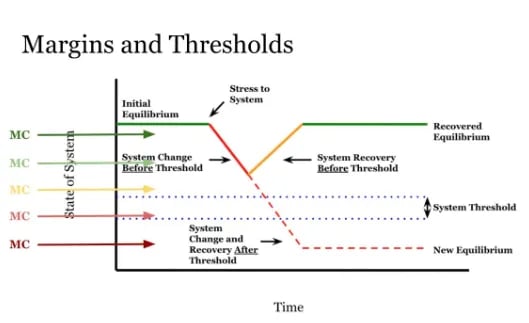
Three subsystems of the ocean are critical to sequestration of CO2:
- Natural ocean chemistry
Naturally the ocean absorbs carbon dioxide CO2 from the atmosphere by reacting with water (H2O) and forms carbonic acid. There typically is an equilibrium between the atmosphere and the ocean, but because we are increasing the amount of CO2 in the atmosphere we are subsequently increasing the amount of carbonic acid. This carbonic acid can then dissociate (when a H+ from an acid detaches in a solution from its ionic counterpart) its H+, which is harmful to marine life and acidifies the ocean. The equation below shows how the chemistry works:
CO2 + H2O ⇌ H2CO3 ⇌ H+ + HCO3- ⇌ 2H+ + CO3 2-
This symbol indicates that this chain is a series of reversible reactions (⇌) that indicate there is an equilibrium, and moving from left to right you can see what happens as the ocean becomes more acidic (the number of H+) we are able to ionise and break down more CO3 2-, which is used in a lot of shells and marine life.
2. The biological pump
The biological pump is processed by which carbon is transported from the surface to deeper layers. Phytoplankton play a critical role in this process, and changes in ocean acidity can reduce their ability to sink to deeper layers and contribute to carbon sequestration.
CO2 and water (H2O) are used by phytoplankton during photosynthesis to produce organic matter (CH2O)n and oxygen (O2). However, as ocean acidity increases, it can make it more difficult for phytoplankton to build their shells and other structures, which can reduce their ability to sink to deeper layers of the ocean and contribute to the biological pump.
3. Calcination of shells of aquatic lifeforms
Ocean acidity makes it more difficult for organisms that build shells or skeletons made of calcium carbonate CaCO3, such as corals, oyster, and some planktonic species, to grow and maintain their structures. This can result in weaker shells, slower growth rates, and higher mortality rates, which can have cascading effects throughout the food chain.
There are two forms of calcium carbonate, aragonite and calcite. Aragonite, typically in tropical corals and pteropods (a form of gastropod — snails) is the form of calcium carbonate that is more susceptible to acidity and is on the front line of species that need to be carefully conserved. These corals and shells typically decay naturally to form limestone, which locks carbon away in the geological cycle, which has a much longer residence time (millions of years) than in the biosphere (10–50 years). If these species are not able to form these shells due to ocean acidity this is a substantial loss of a pathway from carbon to go from the biosphere to the geological cycle. Figure 3 is a model of aragonite concentration in the ocean from 1800–2100 showcasing the projected rapid rate of loss of these biological systems in the next century.
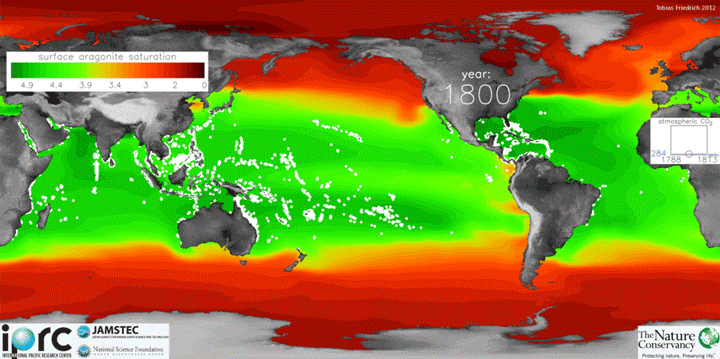
OAE counteracts the alteration of these ocean subsystems and in theory should enable the ocean to stay below the system thresholds as demonstrated in figure 2.
OAE and CDR — State of development
The practice of adding carbonate minerals to stabilise seawater carbonate chemistry has been in use in aquaculture facilities for approximately a decade.⁴ This has been mainly in response to hatchery failures in the US Pacific Northwest and British Columbia due to ocean acidification around 2010.⁵ However, when it comes to large-scale implementation of OAE in open-ocean environments, the current technological readiness level remains limited to laboratory experiments and modelling studies, with a technological readiness scale score of around 3–5.⁶ This means that the technology is between experimental proof of concept and technologically validated in a relevant environment.
The development assessment in this blog we will mainly be focussing on this set of OAE technologies and comply with the same taxonomy that has been presented by Ocean Visions, a non-profit that catalyses innovation at the intersection of the ocean and climate crises. Traditional technologies that might be associated with OAE such as electrochemical⁷, and terrestrial weathering⁸ are not accounted for due to the upstream and downstream processes being fairly different.
The types of technologies accounted for are:
1. Mining and distribution of natural rock-based alkaline minerals, including olivine and other silicate rocks as well as limestone and other carbon minerals, either in open ocean (ocean liming or coastal environments).
2. Production of hydroxide minerals, including lime/slaked lime from thermal calcination and magnesium hydroxide from synthetic weathering of olivine and distribution in the open ocean.
3. Accelerating weathering of limestone (AWL) in ex-situ reactors to sequester non-fossil point source CO2 emissions. Note that AWL requires a concentrated source of CO2 in seawater because carbonate minerals are oversaturated in seawater at ambient CO2 concentrations.
4. Production and addition of hydrated carbonate minerals to seawater for increased alkalinity.
To give a flavour of the types of tests and experiments that are currently being carried out to drive OAE, here are some examples below.
The Chalk-Ex experiment⁹ which crushed calcium carbonate in approximately 1.5km² in the Gulf of Maine. The primary objective of this experiment was to quantify the effects of particles on the upper ocean properties, not to achieve CDR.
Another experiment has been the small-scale (~ 50 x 50m) OAE on a coral atoll using sodium hydroxide in the Great Barrier Reef in order to evaluate the ecosystem response to ocean acidification.¹⁰
Finally, Vesta, a company focused on carbon capture in coastal areas, has announced its intention to carry out a demonstration of coastal enhanced weathering of olivine in Southampton, NY. This will involve adding 500 cubic yards of olivine sand to the coast as part of the second phase of a beach nourishment project. Furthermore, Vesta is concurrently engaged in another demonstration of its technology in Puerto Playa, Dominican Republic.
In summary, while OAE has the potential to be a promising carbon dioxide reduction technology, it is important to carefully consider both its benefits and potential drawbacks before implementing it on a large scale. Further research and testing are necessary to fully understand the long-term effects of this technology on the environment and climate.
AlliedOffsets Database
Currently there are four companies that are providing OAE services are Ebb Carbon, Envirohome, Project Vesta and Skyology, which have been displayed below in Table 1:
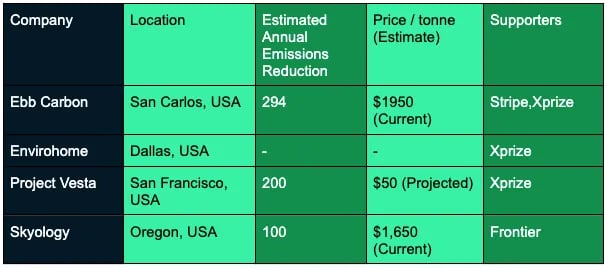
The technological readiness of these projects at level 3–5 is fairly demonstrative of their high prices per tonne. The American University projects OAE credits to be between $70-$160.¹¹ However, the current prices of each of the projects is a factor of greater than 10x higher than this projected cost.
According to BeZero’s CDR scalability report, ocean alkalinization is one of the most promising but nascent CDR technology within the CDR market¹², which explains the fact that each of the OAE companies is not acting independently but being bolstered by supporting entities like XPrize and Frontier.
Notably, Ebb Carbon has received significant investment, recently raising Series A of $20 million and is founded by ex Tesla and Google executives.¹³ This is the largest ocean-based carbon removal investment to date, which is hopefully a signal that there will be commercial growth for this technology and investors are starting to see the importance of the market.
Benefits and Challenges of Using the VCM to Support OAE Projects
Currently, it can be safe to assume that the VCM’s perspective on OAE as a CDR technology is that it is still emerging and while there is growing interest in the potential of this technology, it is still relatively unknown and unproven at scale.
If OAE is taken up by the VCM, there could be several benefits to the technology:
1. Firstly, it would support the development and scaling up of ocean alkalinity enhancement projects, providing much-needed funding and resources for research, development, and implementation.
2. Secondly, it could help raise awareness and understanding of the potential of OAE as a CDR technology both within the market and in broader society. This could drive further investment and support for the technology, potentially leading to greater adoption and impact.
3. Thirdly, it would add another extremely impactful way for companies to offset their emissions and contribute and help encourage greater participation in the market and accelerate the transition to a low-carbon economy.
Overall, the VCM would be a critical funding mechanism to mitigate the effects of ocean acidification on marine ecosystems and reduce the amount of carbon in the atmosphere, supporting livelihoods and ecology around the planet.
Challenges of the Ocean Alkalinity Enhancement
MRV
OAE out of all CDR technologies has the greatest uncertainty owing to the complexity of the ocean system, and there is less scientific consensus owing to its technical immaturity. This causes a very significant barrier to scaling.¹⁴
The can be in the form of knowledge gaps with scientific scaling experiments and lack of widespread proof-of-concept experiments, atmosphere and ocean interface and interaction barrier modelling (what is the background state of CO2 uptake and how are we altering it according to that baseline) and global, local and regional predictions of physical, chemical, and biological outcomes and feedbacks from OAE from high resolution models.¹⁵
Engineering challenges are also prevalent, such as the observational technologies, sensors, remotely operated vehicles (ROV), autonomous underwater vehicles (AUV) and modelling tools are not widespread and fully support field trials, with desired spatial and temporal frequency of monitoring and sampling needed to provide adequately robust MRV of OAE.¹⁶
OAE has minimal policy support measures at a national level and is limited by stringent international policy barriers, leaving it with a very significant barrier to scaling.¹⁷
There is currently no clear international regime that governs research and development of OAE. The closest regimes would be the London Convention and the London Protocol, but currently they are not built to govern OAE scientific field trials in marine waters.¹⁸
Public Perception of OAE
Many of the opportunities and challenges around building public awareness and support for ocean-based CDR are not specific to OAE but there are several hurdles specific to OAE.
OAE faces challenges of public perception of potential environmental risks that are not necessarily faced with what are considered more “nature-based” approaches (e.g. coastal blue carbon restoration).¹⁹ There is a great deal of hesitancy and resistance around any ocean-based CDR pathway that relies on adding materials to the ocean. In addition to this there also seems to be negative perceptions that exist about large scale mining and that there would need to be generated, sufficiently large enough rocks supplies to support global-scale OAE.
Developing targeted public outreach and advocacy campaigns to inform about OAE and its potentials with regards to ameliorating ocean acidification and responding to the narrative of OAE as less “nature-based” than, for instance, coastal blue carbon restoration will be an adequate solution to raising awareness and dispelling negative opinion of the technology.
Conclusion
Ocean Alkalinity Enhancement is a CDR technology and geoengineering technique that increases the capacity of the ocean to store CO2 by adding alkaline carbonate (limestone) and silicate rocks (olivine) to the ocean. The process of alkalinity enhancement also in theory has the ability to counteract ocean acidification which is a massive threat to the ecology of marine life, biodiversity and human livelihoods on the Earth considering how much the ocean system is coupled with weather patterns around the planet.
Currently the technology has technological readiness levels 3–5 and is at small scale field trial stage however there are major challenges to the adoption of this technology. The barriers to adoption are lack of stringent policy levels and governance of such a potent technology, difficulty in knowledge conversion from other fields to help with MRV such as sensor science and robotics, scientific knowledge gaps in ocean modelling and low public awareness and hesitancy to add any substances to the ocean systems.
The adoption of OAE into the VCM would provide the driving force of investment that this CDR technology needs to be able to get itself off the ground in terms of financing for development experiments. It would grow public awareness of the technology and highlight its potential as a method to not just access a carbon sink that spans two thirds of the planet’s surface and sequester tens of gigatonnes of CO2 per year but also to counteract ocean acidification and preserve marine life. The VCM is critical to the uptake of OAE.
Much advocacy needs to be done to raise awareness of the extreme potential upsides of this technology and more future focussed and risk tolerant investment would be able to flow in to increase the development and understanding how to mitigate the threatening risks and downsides of this technology and better understand the ocean system as a whole.
Currently there are only a handful of OAE companies with forward thinking founders who are heavily networked within the sustainability and technology space making good stead in developing the technology. As these companies break new ground and pioneer for a better future for the ocean, they will give confidence to the market that this technology is possible. The question as always in the CDR space, is their pace fast enough and what can we do to accelerate it?
References:
A major amount of this research was taken from the Ocean Visions Ocean Alkalinization Enhancement CDR roadmap.
